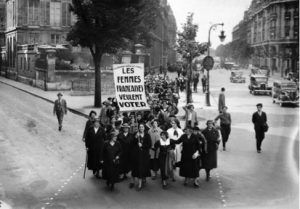Cecile Brunschvicg (1877-1946)
“We demand the unity of morals not so that the woman should have the morals of the man, but that the man should have the morals of the woman”
Cecil Brunschvicg (1877-1946) was a role model for feminists in twentieth century France. She is regarded in France as “the grande dame of the feminist movement.” She was in 1909 one of the founders and continued to be the long-term leader of the French Union for Women’s Suffrage (Union française pour le suffrage des femmes, UFSF) until 1940.
Brunschvicg was born in Enghien-les-Bains in Neuilly-sur-Seine in July 1877 into a Republican, traditional Jewish middle-class family that did not support women studying once they became adults. However, she ignored this and married Léon Brunschvicg, a feminist philosopher and member of the Human Rights League (Ligue des droits de l’homme,) who supported her independence and feminist activism. She led the Women’s Suffrage Society (Société le suffrage des femmes), founded 1883, together with its founder Hubertine Auclert (1848–1914) before 1909, and became its vice-president, next to its president Auclert. Soon, Brunschvicg was also an integral member of several other feminist groups.
One of this groups was the French Union for Women’s Suffrage (UFSF), which was seen by its founders as an umbrella organization of the many smaller local groups of women’s rights activists in France. The UFSF gave these associations a united voice. In the first meeting in Paris in 1909, attended by 300 women, Brunschvicg was elected secretary-general. Jeanne Schmahl (1846-1915) became president and Jane Misme (1865-1935) vice-president; she stayed in this position until her death. The UFSF followed in the footsteps of the earlier more militant group Suffrage des femmes, which had only gained limited support. To change this, the goal of the French Union for Women’s Suffrage was to find the best legal course of action for women’s suffrage. Brunschvicg became president of the French Union for Women’s Suffrage in 1924 and stayed in this position until 1946, when the organization dissolved itself. In 1944, French women finally had gained the right to vote, after the French liberation from Nazi German occupation. As the long-term leader she had a great deal of control over the organization’s policy, especially after taking over as editor for the organization’s periodical.
Brunschvicg had close ties to the republican Radical Party, which accepted women members since 1924. She thought that the best way to cause political change was to influence high ranking male republican politicians by forging a relationship and convincing them of the feminist plight. While many UFSF members after the disappointing rejection of universal women’s suffrage in the French Senate after World War I thought that Brunschvicg’s actions were too moderate to cause any change, her strategy stayed the same. The UFSF became only slightly more radical in the 1920s.
In 1936, she was elected to serve as the undersecretary of state for the Radical Party under Leon Blum (1872-1850), who went on to be the Prime Minister of France for three terms. This gave Brunschvicg a platform to support causes that she felt were underappreciated yet essential for women. For example, she started a program for girls in school to have access to food at lunch and promoted equal treatment of women in schools. Motivated by her upbringing in an unsupportive home, she used her influence to support future generations of women so they would not have as challenging of a road to knowledge as she had.
Brunschvicg was also an important member of the National Council of French Women (Conseil National des femmes françaises, CNFF), founded in 1901, which began small. The CNFF joined the International Council of Women (ICW), created in 1888 in the United States, in 1902 the CNFF, with 40 federated associations representing 28,000 members. In the 1920 the organization reached over 100,000 members. This massive growth represented the development of the French feminist movement; regional chapters had been established across the country since the prewar years.
After World War I, Brunschvicg used her experience to organize the local women’s organization form a broad variety of political positions in a national movement. Brunschvicg was known for her impeccable organizational skills and the ability to mobilize her constituents. This appealed to members of the Radial Party and gave her a unique opportunity to advocate for women within the male-dominated political sphere. At the beginning of World War II Brunschvicg was forced to flee France as a result of her Jewish heritage. She shortly died after the war in 1946. Her activism earned her the title of one of the grandes dames of French feminism. She was perceived by her peers as a pioneer feminist and integral figure to the movement.
Cecile Brunschvicg has been marked as one of the icons of French feminism. She was also one of the first women to become a member of the Radical Party and to be elected to a leadership position in government.
Grayson Holmes, History and Philosophy, Class of 2020
Sources
Literature and Websites
- Caron, Vicki. “Cecil Brunschvicg.” Jewish Women’s Archive: A Comprehensive Historical Encyclopedia, at https://jwa.org/encyclopedia/article/brunschvicg-cecile (Accessed: April 14, 2018).
- “Cecil Brunschvicg.” University of Angers, at: http://bu.univangers.fr/zone/Patrimoine/centre-des-archives-du-feminisme/archives-brunschvicg-cecile-1-af (Accessed: April 14, 2018).
- Newhall, David. “Cecil Brunschvicg.” In Women in World History: A Biographical Encyclopedia. Waterford CT.: Yorkin Publications. 1999.


